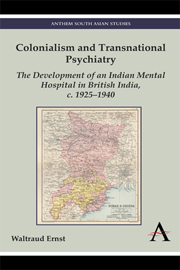 Colonialism and Transnational Psychiatry
Colonialism and Transnational Psychiatry Published online by Cambridge University Press: 05 March 2014
Knowledge linked to power, not only assumes the authority of ‘the truth’ but has power to make itself true.
—Michel Foucault, 1975One of the most pertinent questions in relation to any mental hospital is: who were the people who ended up in it? Who were they prior to becoming ‘patients’ with a particular diagnosis attached to them? Were they ‘village idiots’ and ‘half wits’, as is often assumed; ‘the morally disreputable, the poor, and the impotent, […] vagrants, minor criminals, and the physically handicapped’, as the sociologist Andrew Scull suggested in 1979 for the period prior to the mid-nineteenth century in England?1 Or were they dangerous psychopaths, religious fanatics and ‘mad axmen’, as many fear when they hastily walk past a mental institution? Were the inmates merely somewhat strange ‘eccentrics’ who had developed the Indian version of the British colonials’ ‘doolally tap’ syndrome where they went ‘pagal’ (‘mad’)? Were they just a mixed bag of inconvenient family members and depressed women, political rebels, uncooperative Indian princes or intractable tribals who were locked away?
Evidence for each of these characterisations can be found in hospital records and medical, official and patient accounts all over the world. Sociohistorical analyses that set themselves apart from previously preferred ‘Whig’ narratives that celebrated the progress of biomedicine in Western science-based psychiatry have tended to focus on mental institutions as means of social, political and gender control, where formerly autonomous people were forced into the role of the ‘passive patient’.
To save this book to your Kindle, first ensure [email protected] is added to your Approved Personal Document E-mail List under your Personal Document Settings on the Manage Your Content and Devices page of your Amazon account. Then enter the ‘name’ part of your Kindle email address below. Find out more about saving to your Kindle.
Note you can select to save to either the @free.kindle.com or @kindle.com variations. ‘@free.kindle.com’ emails are free but can only be saved to your device when it is connected to wi-fi. ‘@kindle.com’ emails can be delivered even when you are not connected to wi-fi, but note that service fees apply.
Find out more about the Kindle Personal Document Service.
To save content items to your account, please confirm that you agree to abide by our usage policies. If this is the first time you use this feature, you will be asked to authorise Cambridge Core to connect with your account. Find out more about saving content to Dropbox.
To save content items to your account, please confirm that you agree to abide by our usage policies. If this is the first time you use this feature, you will be asked to authorise Cambridge Core to connect with your account. Find out more about saving content to Google Drive.